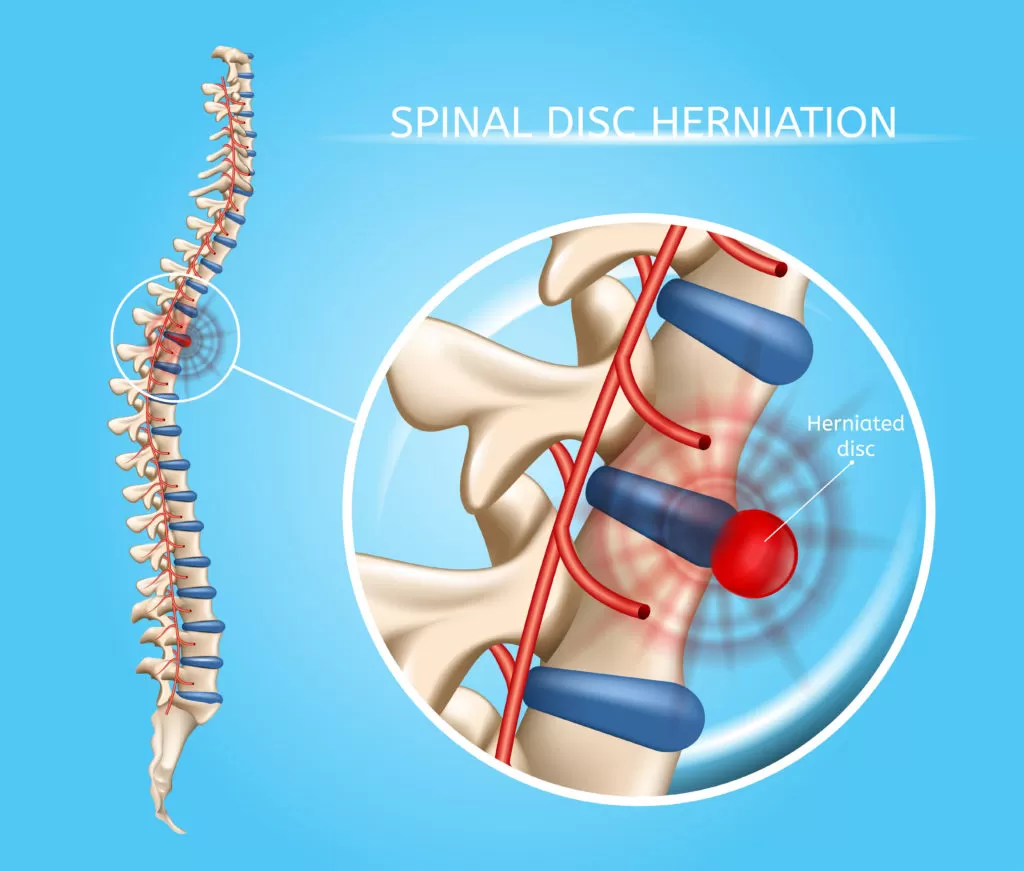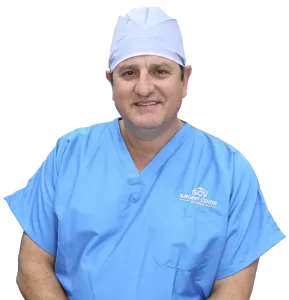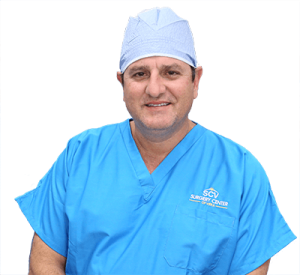
The most common variant of spinal injury is a herniated disc.
This condition can cause back or neck pain, arm or leg discomfort and even advance into more complicated syndromes such as sciatica, pinched nerves, radiculopathy, or myelopathy. Fortunately, herniated discs can now be safely repaired (Deuk Laser Disc Repair) by a qualified surgeon competent in the proper technique. Repairing herniated discs is now possible; however, it requires extensive training in endoscopic spine surgery and skill using medical grade Holmium-YAG lasers. More invasive but less successful treatments for herniated discs, such as fusion or total disc replacement are more readily available worldwide but have bad complications, longer recovery and require the use of dangerous opioid painkillers for weeks after surgery is completed.
There are 23 intervertebral discs in the spinal column: 6 cervical, 12 thoracic, and five lumbar. These discs are soft tissue joints composed of a hydraulic gelatinous core called the nucleus pulposus encased within a firm outer collagen wall termed the annulus fibrosus. The discs protect the spinal vertebrae and nerves from sudden impact. They also absorb shock from movements of the spine like bending, twisting and jumping. Unfortunately, the disc’s outer wall, the annulus fibrosus, can develop traumatic tears (annular tear), allowing the jelly-like nucleus pulposus to push backward out of the tear into the spinal canal or neural foramen.
The part of the jelly nucleus pulposus that pushes out through the tear is called the herniation. In many cases, this hernia can impinge on a nerve, giving rise to inflammation and irritation of the affected nerve.
Disc herniation is caused by several factors which can affect the joints individually or as a combination. The most prevalent of these factors is wear and tear in the spine. As humans age, the cartilage that connects the discs in the spine to the corresponding vertebrae members can become lax and lose elasticity. Herniated discs can also be caused by sudden impact and trauma from accidents or falls.

When herniated discs cause back or neck pain and the pain doesn’t resolve on its own within a few months, surgery on the disc becomes the best treatment option.
If you would like to know more about potential causes of back and next pain, watch the video below;
The type of surgery used to treat herniated discs is called spine surgery and traditionally included microdiscectomy and spine fusions until various more advanced techniques were developed, like deuk laser disc repair, to expedite recovery and operation time and improve pain relief capability. More traditional spine surgery is performed under general anesthesia. Upon completion, patients are typically required to remain in the hospital for observation, ranging from 2 days to multiple weeks. Additional post-surgery requirements are stipulated to prevent overexertion of the back and avoid post-operative re-damage.
There are different surgery options available for patients who have been diagnosed with herniated discs. The surgical treatment selection typically depends on two factors; the associated symptoms and severity of the patient’s injury. These options range from minimally invasive surgical procedures to artificial disc replacements or spinal fusion in extreme cases. Before a procedure is selected, patients are advised to consult a spine expert to conduct a full MRI scan and allow for a thorough examination and subsequent localized diagnosis.
The most advanced surgery in the world for a herniated disc is the Deuk Laser Disc Repair. This procedure is performed endoscopically with a small 7mm incision. The surgery is virtually bloodless and takes 30 minutes per disc being repaired. You heard correctly, your own natural disc will be repaired so that it no longer causes you pain and the effect is permanent. The laser employed for this process is the most precise medical instrument currently available for surgical use with an impressive ½ millimeter precision. A high definition endoscopic view inside the damaged disc is used to maximize accuracy of the newly developed (at Deuk Spine Institute exclusively) annular debridement, performed to eliminate painful tissue inside the disc. Only the laser annuluar debridement of the Deuk Laser Disc Repair procedure will allow natural disc healing without the need for metal screws-rods, artificial discs or dangerous biological spine implants used by surgeons to promote fusion. What this means for patients choosing Deuk Laser Disc Repair is that recovery time is shorter, less than 1 hour, compared to long recovery times for fusions, laminectomies and artificial discs which last months. Finally, when you compare Deuk Laser Disc Repair to other types of spine surgery, DLDR has the highest pain relief (98%), lowest risk of surgical complications (zero to date), fastest recovery (52 minute average), least amount of blood loss (average of 10 drops), lowest cost and fastest return to work and life. Why would anyone want invasive, dangerous surgery that works less than 50% of the time? In fact, when you really understand how much better Deuk Laser Disc Repair is than traditional surgeries like microdiscectomy, laminectomy, spinal fusion or total disc replacement, your mind is easily made. Traditional spine surgery is dangerous to your health and completely unnecessary.
An MRI scan and a detailed physical exam are necessary to establish the herniation’s scope, location, and degree(s). Afterward, a suitable surgical procedure can be recommended if it is considered necessary.
Herniated disc surgery is usually conducted to alleviate the effects of the herniated disc. Under general circumstances, herniated discs cause pain because of the nerve fibers around the inflamed tear in the annulus. Inflammation occurs when the herniated nucleus pulposus wedges itself inside the annular tear. The effect of this “interposed” herniated nucleus pulposus on the annular tear is to generate a powerful inflammatory response inside the disc. Leg or arm pain occurs when the herniated disc irritates or pinches a nerve, it affects the sensory and motor areas connected to the nerve root. Therefore, patients who suffer from a herniated disc might experience difficulty in completing basic daily tasks.
In most cases, such patients lose sensation in certain parts of the body, ranging from the arms to the palms and fingers. Specific affected regions will depend on the location of the herniated discs within the spine as cervical and lumbar disc herniation tend to cause different symptoms. It is also quite usual to feel pain in the shoulders, legs, neck, and back due to the inflammation of the nerve roots that control motion in these regions. All these symptoms can be discomforting and obstructive to day-to-day activities. Thus, surgery becomes necessary to subdue the effect of herniated discs. This is achieved by relieving the pressure that the herniated disc tissue exerts on the affected spinal nerve and removing the cause of nerve inflammation, i.e., the herniated portion of the tissue.

If you are in pain, yes! Opting for surgery depends on the patient’s diagnosis as well as personal preferences. Surgery for a painful disc herniation is recommended for patients who have attempted medical treatments for back pain or neck pain for at least 2 months. During the first 2 months after injury, patients should attempt non-surgical treatments such as activity restrictions, therapy and anti-inflammatory medication before turning to spinal surgery as a final resort. There are exceptions to this general rule and they include pinched nerves, spinal cord damage and spinal instability, all of which need immediate surgery without delay.
Traditional types of spine surgery are commonly performed by surgeons not trained in the latest surgical techniques, but are they the patient’s best option? There are a variety of options that patients can explore outside of traditional lumbar discectomy, laminectomy or microdiscectomy, all of which can only ease leg symptoms at best and do nothing for back pain. For example, oral pain medications and administrable injections will marginally reduce the effects of herniated discs, including the associated arm or leg pain or radiculopathy because the medications effects are not targeted to the source of pain but diluted throughout the body. Conservative measures include nonsteroidal anti-inflammatory drugs (NSAIDs) and epidural steroid injection. The problem is that these medications have short-lived beneficial effects at best and patients would need a lifetime of treatments not to mention the side effects and complications that frequently occur from their prolonged use.
Patients can likewise opt for physical therapy and exercise but unfortunately neither will stop the pain emanating from a damaged disc and most patients report that therapy aggravates their pain when it comes from a herniated disc. Physiotherapy is widely recommended for all herniated discs patients, regardless of whether they choose to have surgery or not. The purpose of therapy is to maintain good posture, balance and tone while the body attempts to heal the damaged disc(s) on its own. However, doctors will often recommend surgery if the condition is severe and causing prolonged pain and disability. Rare symptoms might include a loss of control of both bladder and bowel movements. In such cases, immediate medical action is recommended before complications develop in the digestive system.
As a general guide, herniated disc surgery is appropriate for patients who exhibit any of the following symptoms;
Spinal surgery is the most effective method for the treatment of herniated discs, including bulging discs, in the spine. Below, we highlight some of the procedures offered by Deuk Spine Institute;
This revolutionary procedure is Deuk Spine Institute’s specialized alternative to dangerous invasive surgeries like spinal fusion or total disc replacement. The laser disc repair does not weaken or compromise the health and integrity of the spine. Our modernized approach to laser spine surgery has a 95% success rate with no complications in any patient over 15 years of performing this procedure and over 1,300 patients treated.
Deuk laser disc repair surgery is a form of endoscopic spine surgery performed in our state of the art surgery center under sedation while the patient relaxes. Through a ¼ inch incision, the injured disc is visualized using an endoscope and live imaging via a high definition camera attached to the spinal endoscope. With this method, Dr. Deukmedjian carefully eliminates only the injured disc tissue causing pain and discomfort and leaves the rest of the patient’s own natural disc in place to preserve spinal motion and function. Fusions and artificial discs are not necessary because the patient’s repaired natural disc is left in place.
Deuk Laser Disc Repair uses a precision laser to vaporize the herniated tissue and provide the most effective laser spine surgery available. Bone and surrounding tissues are not damaged or removed during this procedure, unlike traditional microdiscectomy, artificial discs and spinal fusions.
Dr. Ara Deukmedjian uses FDA approved tools to access the disc through a natural space in the spine where he does not drill through bone as is done with microdiscectomy. Drilling through bone weakens the spine, which leads to future complications that may require fusion surgery. Once the herniation and annular tear have been gently vaporized, the body can heal naturally. Irritation around the spine decreases, and neurological symptoms from nerve root pressure subside. In time, the disc functions as it did before injury and herniation. After surgery, patients wake up to immediate relief and a surgical scar so small the surgeon can cover it with a Band-aid. Only a few drops of blood are lost and no hospitalization is required. All 1,300 Deuk Laser Disc Repair surgeries done to date have been outpatient with a 1 hour recovery.
“The surgery only takes about 1 hour. Throughout the entire operation, I did not feel a thing. I woke up and all my pain was gone. I am walking better than I have in years.”
“It was such a wonderful professional experience. Dr Deuk is the best in the world. I only have a little pimple-sized incision and absolutely no scars. My full range of motion is back and I can not wait to go back to dancing and all the things I have been so nervous about. I could cry, I am so happy.”
The cost for this procedure includes fees charged for the following;
Request a free MRI review for a complete quote
There are two variants of discectomy surgery that patients can undergo; an open discectomy or a microdiscectomy. Discectomy is far more invasive than endoscopic laser spine surgery and as such has more complications, postoperative pain, longer recovery and more scar tissue.
The main distinction is that an open discectomy features a larger incision, more normal spinal bone and ligaments are removed, more scar tissue and pain than a microdiscectomy. This procedure gives room for the underlying risk of nerve damage to the neighboring nerves of the vertebrae. The spinal column can also become unstable due to the removed bones, ligaments, and facet joints. In such cases, a spinal fusion is conducted following the discectomy to re-stabilize the spinal column, marginally increasing the patient’s recovery time.
Spinal fusion can be done to treat painful disc herniations. This surgery is far more invasive than laser spine surgery or discectomies. The outcomes of fusion are better for treatment of back pain and neck pain when compared to discectomy because the fusion stops movement at a painful joint. Fusions are harder for spine surgeons to perform properly and many spinal fusions are done with poor planning and technique resulting in bad outcomes for the patient. You can see a comparison of cervical fusion to deuk laser disc repair here:
Lumbar disc herniations can be fused with good success but the dangers and invasiveness of fusions is far greater in the lower back as seen in this comparison video here.
It is not uncommon for herniated disc symptoms to naturally heal over days or weeks. Patients can immediately prepare to undergo surgery in cases where severe symptoms persist, such as those addressed in the section above; (Should You Have Surgery for Your Herniated Disc).
Patients are always advised to have an MRI scan done before opting for back surgery or any other form of herniated disc treatment. This is always useful to ascertain the full extent of the condition and determine the appropriate surgical procedure. If you have already completed this step and would like a free consultation on your MRI scan, please submit it here, and our team will reach out to you. In cases where the herniated disc causes a pinched nerve, an EMG-NCS may also be ordered. For patients unable to get an MRI scan due to restrictions, a CT scan could be useful.
Once a patient decides to undergo herniated disc surgery, the natural next step is to prepare for it. This process begins by organizing a consultation with the operating surgeon to establish certain information such as the expected recovery rate, any side effects to be anticipated, a follow-through of the operating procedure, dietary or lifestyle restrictions to follow, and other related queries.
While this is not a requirement, the patient is also encouraged to conduct an independent background search on the clinic. It is advisable to research basic information such as the reputation of the clinic, its physicians, and any past testimonials.
At Deuk Spine Institute, we advise patients to complete a series of tests before fixing their surgery date. These include Lab tests, EKG, and clearance (possible chest X-Ray). Full disclosure on all existing medication is also required from our patients. This is necessary to prescribe replacement medication that will aid the surgery and post-op recovery process.
Herniated disc surgery is a highly effective treatment for spinal discs conditions. Recovery periods and rates will typically vary depending on the surgery type and the surgeon’s competence.
Patients are advised to engage the services of a physical therapist to hasten the recovery period. This has many advantages, including regaining mobility faster and preventing injuries due to careless movement.
A general recovery guide is to abstain from strenuous physical activity for a few weeks following the procedure. This usually involves lifting heavy objects, prolonged sitting or standing, and any bending or stretching activity.
When you undergo your surgery with Deuk Spine Institute, the post-op recovery phase is accelerated. Our patients enjoy personalized rehabilitation therapy with our in-house specialist, who prescribes exercises to recondition the muscle and prevent irritation.
Herniated disc surgery naturally has a high success rate. Most patients are often able to resume their normal lifestyle within days of undergoing surgery. At Deuk Spine Institute, our patients receive expert outpatient care, eliminating the need for hospitalization and the consequent risk of infection or complications. Patients can leave immediately after their surgery, and they can expect to be back to their usual schedule within days.
If you would like to enjoy premium patient-oriented care delivered by world-class physicians, contact us at Deuk Spine Institute today. We also offer free consultation on your MRI scan. Visit our site here to start your treatment.

